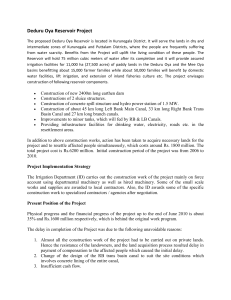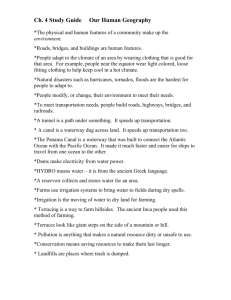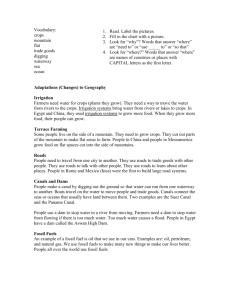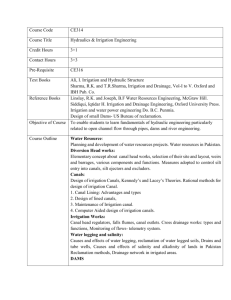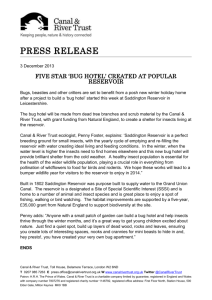Meeting Notes - Henry`s Fork Foundation
advertisement
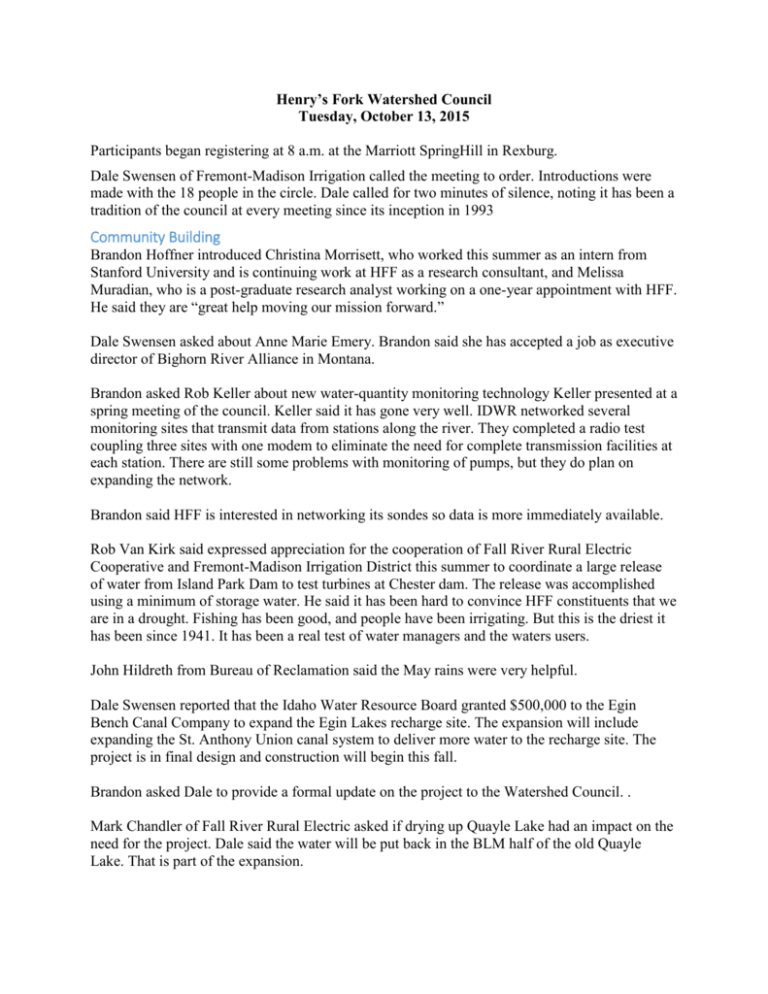
Henry’s Fork Watershed Council Tuesday, October 13, 2015 Participants began registering at 8 a.m. at the Marriott SpringHill in Rexburg. Dale Swensen of Fremont-Madison Irrigation called the meeting to order. Introductions were made with the 18 people in the circle. Dale called for two minutes of silence, noting it has been a tradition of the council at every meeting since its inception in 1993 Community Building Brandon Hoffner introduced Christina Morrisett, who worked this summer as an intern from Stanford University and is continuing work at HFF as a research consultant, and Melissa Muradian, who is a post-graduate research analyst working on a one-year appointment with HFF. He said they are “great help moving our mission forward.” Dale Swensen asked about Anne Marie Emery. Brandon said she has accepted a job as executive director of Bighorn River Alliance in Montana. Brandon asked Rob Keller about new water-quantity monitoring technology Keller presented at a spring meeting of the council. Keller said it has gone very well. IDWR networked several monitoring sites that transmit data from stations along the river. They completed a radio test coupling three sites with one modem to eliminate the need for complete transmission facilities at each station. There are still some problems with monitoring of pumps, but they do plan on expanding the network. Brandon said HFF is interested in networking its sondes so data is more immediately available. Rob Van Kirk said expressed appreciation for the cooperation of Fall River Rural Electric Cooperative and Fremont-Madison Irrigation District this summer to coordinate a large release of water from Island Park Dam to test turbines at Chester dam. The release was accomplished using a minimum of storage water. He said it has been hard to convince HFF constituents that we are in a drought. Fishing has been good, and people have been irrigating. But this is the driest it has been since 1941. It has been a real test of water managers and the waters users. John Hildreth from Bureau of Reclamation said the May rains were very helpful. Dale Swensen reported that the Idaho Water Resource Board granted $500,000 to the Egin Bench Canal Company to expand the Egin Lakes recharge site. The expansion will include expanding the St. Anthony Union canal system to deliver more water to the recharge site. The project is in final design and construction will begin this fall. Brandon asked Dale to provide a formal update on the project to the Watershed Council. . Mark Chandler of Fall River Rural Electric asked if drying up Quayle Lake had an impact on the need for the project. Dale said the water will be put back in the BLM half of the old Quayle Lake. That is part of the expansion. Restoration and Enhancement of Harriman Canal (W.I.R.E. Process) HFF and Harriman State Park Brandon Hoffner, HFF, said the need for work on the Harriman Canal was brought to our attention by anglers. The stretch of the Henry’s Fork through Harriman State Park is the most used section of the river. A natural spring near one of two diversions on the canal creates a bog, and fisherman frequently develop new trails through the muddy area trying to get to the river. The Harriman Canal diverts water from the Henry’s Fork upstream from the Last Chance Fisherman Access and parallels the river for about one mile before delivering the water to a system of laterals used to irrigate 450 acres of pastureland used for grazing cattle. Harriman State Park is a working cattle ranch under terms of the agreement with the Harriman family, who donated the former Railroad Ranch to the state of Idaho for a state park. The water right belongs to Harriman State Park, which is responsible for maintaining the canal, even though much of the structure is outside the park boundaries, said John Sullivan, park manager. Excess water from the canal that is not needed for delivery into the lateral system is returned to the river at two control points. The physical control structures at those return-flow points are in poor shape, and plastic tarp-dams are used to control flows. The canal has eroded, and in the past the tarp-dams have failed and allowed sediment into the river. A temporary-type wooden foot bridge is used for access across one of the return-flow ditches, but it is also in bad repair. It was found in 1998 that about 100 fish use the canal to overwinter, so a winter flow water-right and delivery procedure was established to allow those fish to survive in the canal during the winter. However, because of construction of the Buffalo River fish ladder in 2005, the Buffalo River now produces hundreds of thousands of trout each year that contribute to the Henry’s Fork fishery Therefore, maintaining winter flow in the Harriman Canal to support survival of 100 fish isn’t worth the cost, Brandon said. The canal has an 1891 irrigation water right for 30 cfs, and an 1898 right for an additional five cfs. HFF and Harriman State Park propose hiring an engineering firm to design repairs to the canal and diversion structures, and a fish screen at the main diversion from the river, to minimize damage to the riverbank and the river itself, improve irrigation management, and minimize the chance of summer-time mortality of fish in the canal. Timeline is for construction to begin fall 2016 after the main fishing season. Brandon said the project is estimated to cost $143,000, and funding for about $120,000 has been secured through grants. Harriman has put in a request for state funds from Capital Needs Projects for 2017. John said he has been assured the project will be funded for FYI 2017, which begins July 1, 2016. Brandon said the project was brought to the Council for W.I.R.E. to share it with the agencies and stakeholders, and receive technical input. HFF has decided to bring all its projects to the council to avoid any problems. He noted that most of the water diverted into the canal returns to the river downstream. The pasture is irrigated by a series of laterals. The first diversion would be replaced by a calibrated, or automated, weir. Brandon’s presentation is available online. Rob Van Kirk asked Lyle Swank about whether the winter water right might be forfeited if we no longer use it for fish habitat in the canal. Under that right, water can only be diverted into the canal when there is 300 cfs in the river, from mid-October through March. That winter flow was used to keep enough water in the canal to support fish through the winter. With a fish screen at the headgate, the winter water right would not be used, and the water right could be lost. Lyle Swank, Water District 1 watermaster, said that the forfeiture procedure is more complicated than that, but the water right could be challenged if it isn’t used for five years. Lyle asked about angler damage to this stretch of river since it is so busy. It was noted that damage in this stretch from anglers is just as bad as it is from cattle. That isn’t the case on stretches where the riverbank is drier. Garth Blanchard, Ashton area resident, said that if part of the problem is public perception, we should take advantage of the visibility to develop a media campaign plan. The participants were divided into two groups to conduct the W.I.R.E. Highlights of W.I.R.E. Sessions Group I: Brandon Hoffner Brandon gave highlights of the discussion: We might need to mitigate the loss of the wetland created by the natural spring. The wetland is already being degraded by the trails made by anglers. We still need to finish some permit processes. While this is not a huge ecological issue, it is necessary because of the high visibility and use of the area. Group II: Dale Swensen We need additional research on fish screens that might work in a low-gradient river such as the Henry’s Fork that also has a large growth of macrophytes. Installing a weir will protect the water right. There is concern that one-third of the funding is two years out. How do we cover the costs? We need interpretive information, signage, to meet the social and cultural needs. We need to consider the grazing permittees in the economic impact portion of the W.I.R.E. John Sullivan said the state is ultimately responsible for the main canal, but the actual irrigation is the responsibility of the permittees. Work will be done around the grazing to avoid conflicts on the allotment. Most construction will be done in the fall. No §404 permit is necessary for work on the headgate or in the canal but may be necessary in the area of the spring and wetland, he said. NRCS Special Regional Conservation Partnership Program (RCPP) Howard Johnson, NRCS, Rigby The RCPP is really new, the result of the 2014 Farm Bill. The federal government identified critical conservation areas, one of which is the Columbia River Basin. The East Snake River Plain Aquifer RCPP is in place now. The Idaho Department of Water Resources submitted an application for RCPP and received $1.1 million to stabilize and recover groundwater levels in the ESRPA. This involves end gun removal and irrigation-to-dryland conversion, retrofitting variable rate irrigation devices on central pivots, flood irrigation enhancement, and Thousand Springs conservation projects. In eastern Idaho, there are three areas identified as critical to the aquifer stabilization: Mud Lake, Camas, and Snake River/Idaho Falls, where flood irrigation will be enhanced to recharge the aquifer and prevent conversion to pivots. Brandon asked if the Watershed Council can still apply for funding. Johnson said he doesn’t know what the 2016 deadlines are. The key to success is matching funds (1:1 match is required). Johnson’s PowerPoint presentation is available online. Recap of the Water Year John Hildreth, Bureau of Reclamation John began by comparing reservoir levels on Oct. 1, 2014 (41 percent of capacity), June 17, 2015 (88 percent), and Oct. 1, 2015 (29 percent). He pointed out that May rains helped the water situation, and we have started putting water in American Falls for next year. He then reviewed the Coordinated Forecast for Snake River flows at Heise, which showed that streamflow forecasts were near average on January 1 but dropped steadily throughout the late winter and spring due as precipitation during January, February, March, and April were all well below average. The reservoir system was drafted in April due to early irrigation demand but decreased in May as rains lowered demand. We ended the water year in pretty good condition for next year. We can expect minimum flows by November. As for the 2016 outlook, we are expecting a warm winter and very dry again. However, some “weird ocean temperatures” are forecast, and we are “not certain how that will play out.” Conclusions: Carryover is below 2014 but good overall. We need high system storage (snowpack) We will see minimum winter flows at most locations throughout the system Weather forecasts lack confidence. John’s presentation is available online. Asked about cloud seeding, Dale said contractors are setting up ground-based generators and should be done by Nov. 1. Idaho Power is participating again this year and supplying an aircraft for eastern Idaho that will make it possible to seed more storms. The aircraft can seed clouds that gather from an unexpected direction and that the ground-based generators can’t reach. The IWRB agreed to help fund the aircraft for eastern Idaho. Normally, cloud seeding will add 5 percent to 8 percent additional precipitation in a season. The aircraft enables another 2 percent to 3 percent. Updates on Previous W.I.R.E. Projects Melissa Muradian, HFF Water-Quality Monitoring HFF’s water-quality program records and measures river conditions, building a context for management decisions. HFF currently has seven sondes deployed and will expand the networks by four more next year. Data is collected in two ways: 1. Sondes – These record information every 15 minutes. The data is downloaded onto a laptop. 2. Water samples are collecting weekly during the summer and measure turbidity, sediment, and phosphorus. HFF worked with DEQ and other agencies to monitor water quality in the reservoir to determine how water quality is impacted by releases from the dam. Sondes were installed on both sides of the river immediately downstream of the dam, and an addition sonde was used to collect depth profiles of water quality in the reservoir at three locations. The reservoir was fairly strongly stratified early in the summer, with both temperature and dissolved oxygen decreasing with depth. During the period of high irrigation releases, when the reservoir was dropping rapidly, stratification broke down, and temperature and dissolved oxygen showed little change with depth. When irrigation delivery decreased, the reservoir stratified again. Dissolved oxygen and temperature on the power-plant side of the river generally reflected reservoir conditions at the depth of the power plant’s intake siphon. On the west side of the river, downstream of the bottom-withdrawal dam gates, water temperature reflected that of the bottom of the reservoir, but when at least 200 cfs was being delivered through the dam gates, dissolved oxygen was much higher than either on the reservoir bottom or on the power-plant side of the river due to turbulent mixing as water traveled through the tunnel and into the river. In general, water temperatures and dissolved oxygen concentrations were more favorable for trout while water was being released through the dam gates, at the cost of slightly higher turbidity. However, the increase in turbidity from the higher flow releases was small—from a background level of around 4 turbidity units up to around 8. Water-quality standards generally require turbidity increases associated with construction or other temporary activities in the river to remain below 50 turbidity units above background, so the increase from 4 to 8 is of little consequence. An unexpected opportunity presented itself when the power plant at the dam tripped off, three times within a short time during late September and early October. Data from these incidents clearly showed that dissolved oxygen increased each time the outflow was transferred from the power plant to the gates and dropped again when flow was transferred back to the power plant. Melissa’s PowerPoint presentation is available online. Rob Van Kirk said the water from the gate side of the dam puts more oxygen into the water than the aeration basin on the power plant side. Dave Peterson, from Fall River Electric, said they are not operating the aeration basin, which explains why dissolved oxygen has been lower on the power-plant side of the river. Rob Van Kirk, Ashton Wastewater Treatment Plant The treatment plant discharges into the receiving body (referred to as the swale) only four months of the year. The rest of the time, the effluent is applied to adjoining fields to irrigate livestock feed crops. Discharge from the wastewater treatment plant is the smallest source of water to the swale; most of the water in the swale is irrigation return and storm water. The high water table early in the spring results in high water depth at zero discharge at the culvert, making it impossible to develop storage/discharge relationship. Flow is influenced by storm water and upstream irrigation. The swale can’t support aquatic life in two to four inches of water with minimal flow. At the weir, flows ranged from 0.05 to about 1 cfs most of the summer except during a few rain events. Other observations: Utah chubs found in the swale are a water-water species; the question is whether it can sustain cold-water species The vegetation at the treatment plant indicates wetlands, not riparian areas. Invertebrates are generally absent from the substrata. The swale is not geologically connected to Spring Creek, suggesting that it is largely a product of irrigation return. The swale does have value for wildlife habitat, primarily waterfowl. The swale doesn’t support cold-water aquatic life. We will continue monitoring until ice and snow completely freeze any water remaining in the swale. Rob’s presentation is available online. Community Building and Wrap-Up Attendance climbed during the morning to more than 30 but was down to 18 for the closing session. Brandon announced the next meeting would the annual watershed conference Nov. 10 at the SpringHill. Agencies, partners, and other groups will look at the watershed, hot topics, and future projects. An agenda will be distributed as soon as it is finalized. After observing a minute of silence, the meeting was open for closing comments. John Sullivan gave a shout out to Brandon and HFF for help with water resources issues and problems at the Harriman Fish Pond, which is located east of the main park down S.H. 47. A gate failed, and the pond was drained. Now there is no fish pond. On advice from HFF, he contacted IDWR and Fish and Game. Repairs will be started Oct. 19. Rob thanked Fish and Game and DEQ for help with the reservoir study. They provided boats, sondes, and an intern. We even got help from USGS one day to look at stratification in the reservoir. The meeting was adjourned at 12:15.
